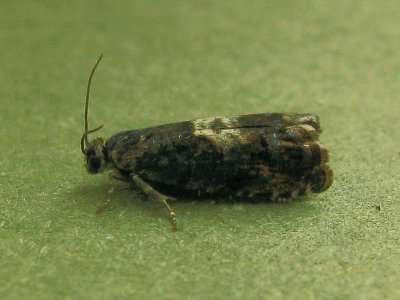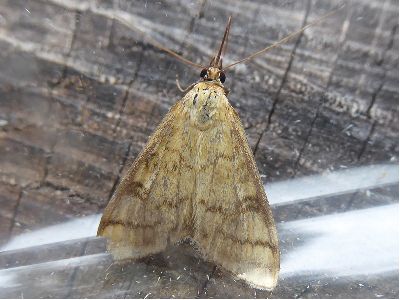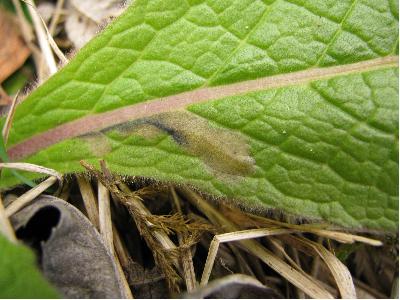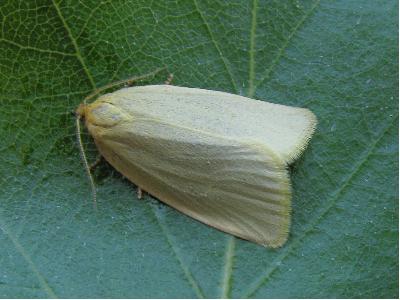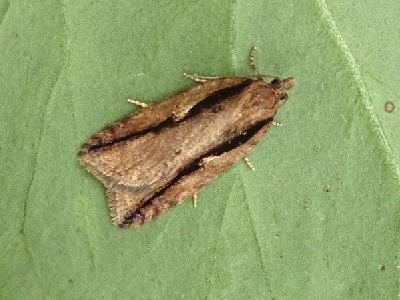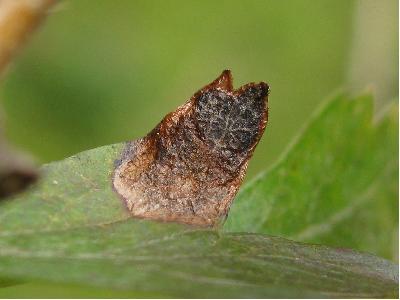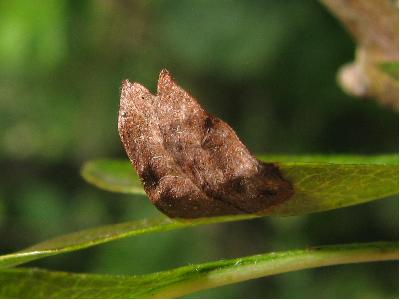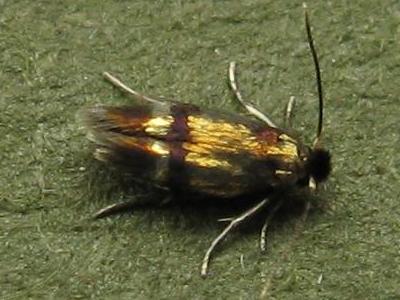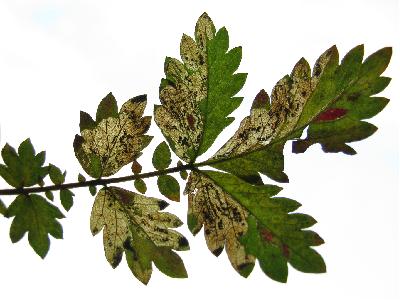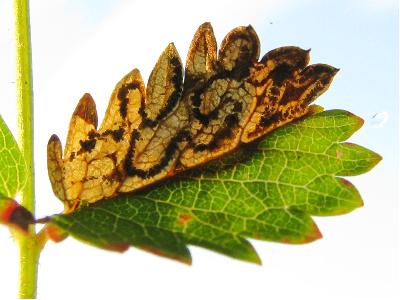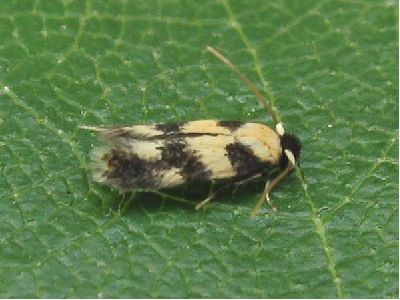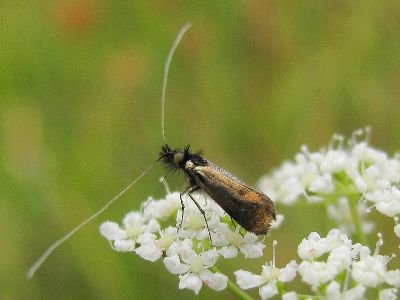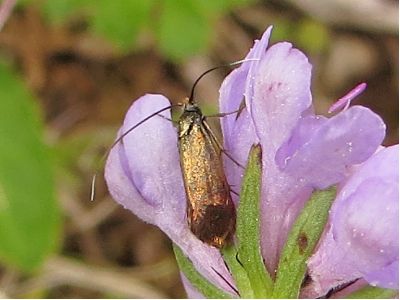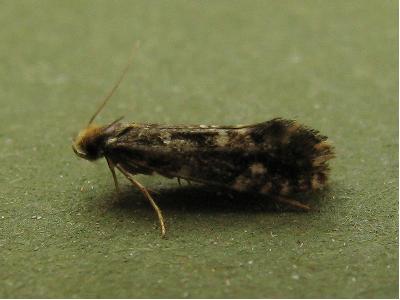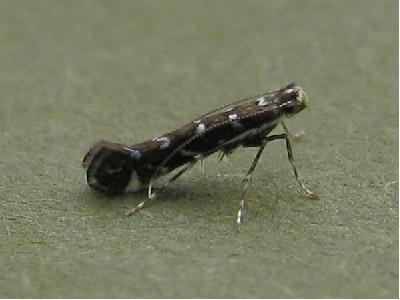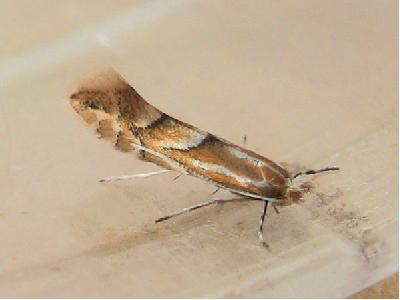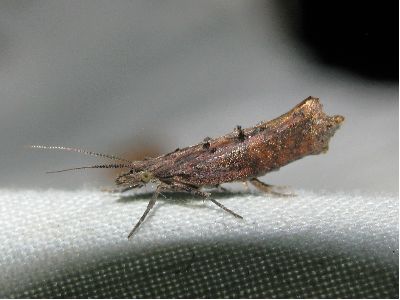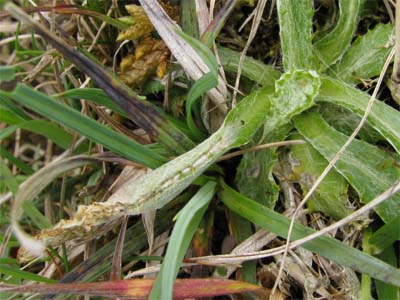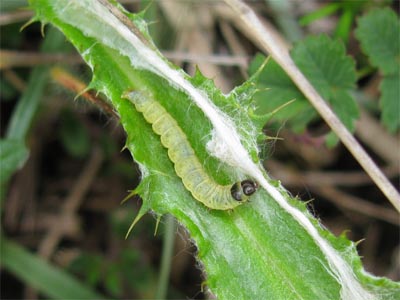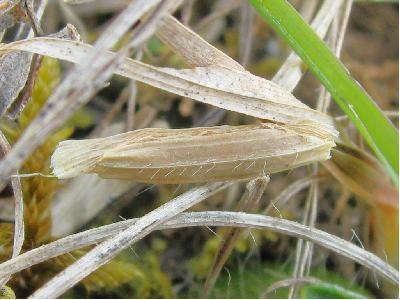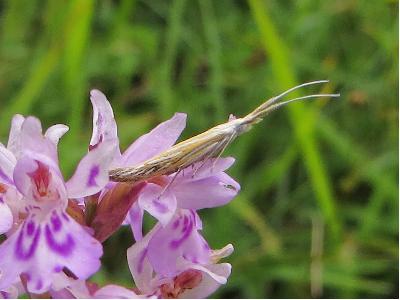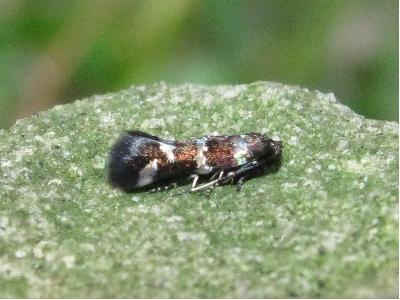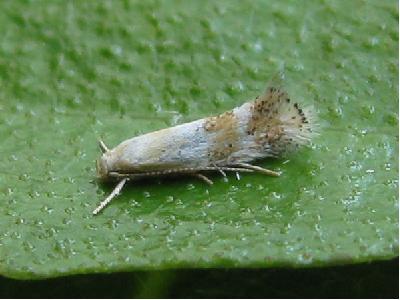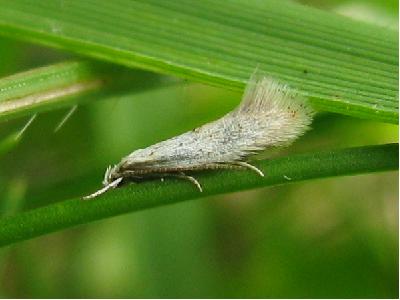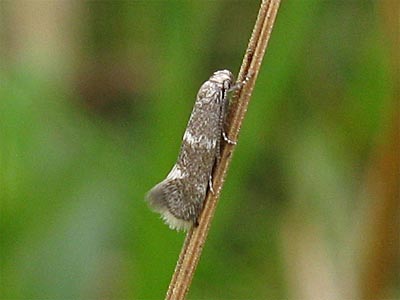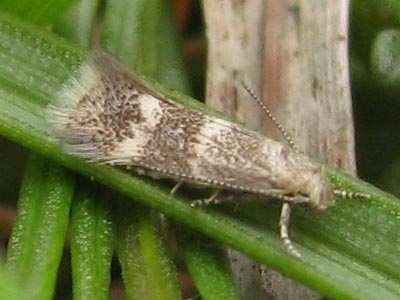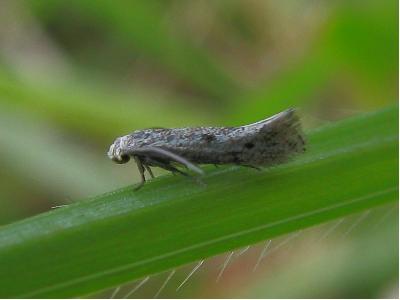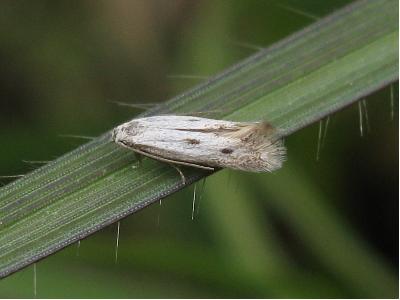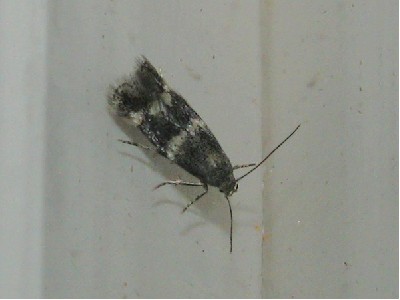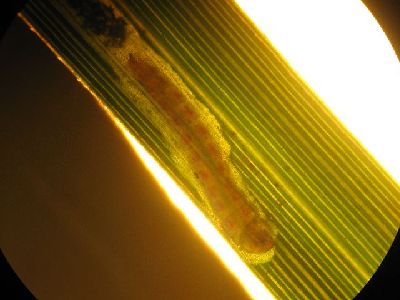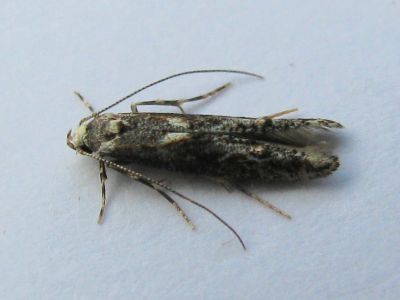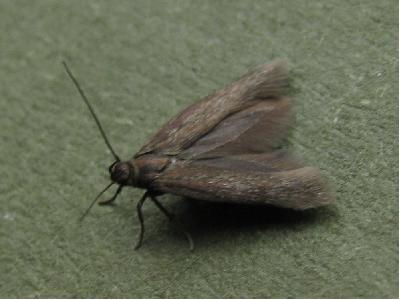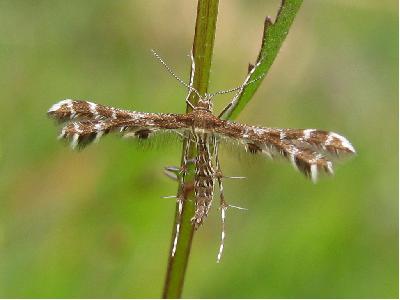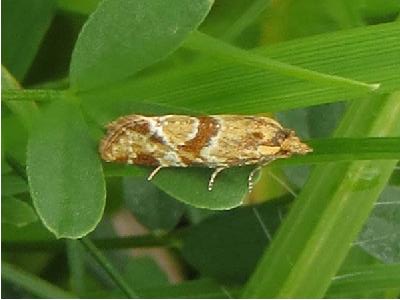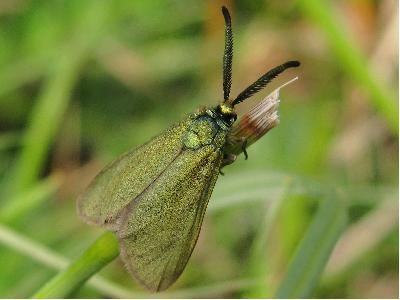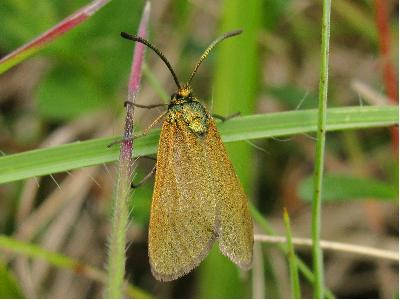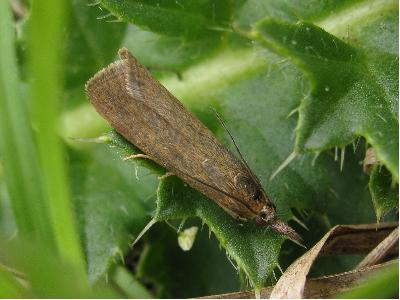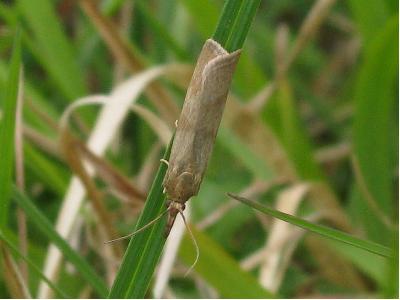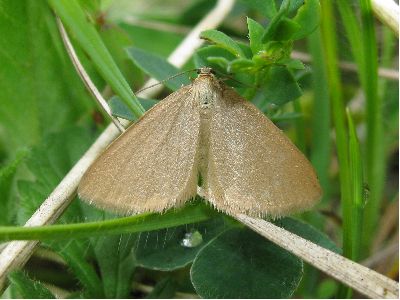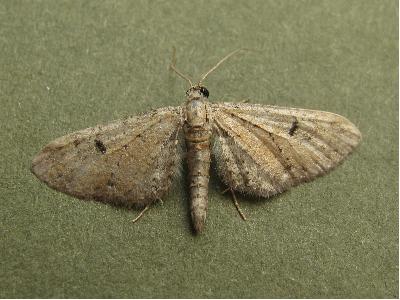57 Rare & Scarce Moth species recorded at Rough Bank
Since 2012, the year when Butterfly Conservation purchased Rough Bank reserve, a total of more than
770 moth species
have been recorded on the site and there is one other species only recorded prior to 2012.
The Rough Bank Moths page gives a full species list.
57 of the species recorded at Rough Bank are rated as nationally rare or scarce in the UK.
Most of these are believed to be resident on the reserve because of the habitat and the presence
on site of their larval foodplants.
Many of these species have been found here at least 3 times since 2012. The exceptions to this are
indicated in the text below, though in some cases these have been found on site as larvae or larval mines
rather than as adults which could have flown onto the site from elsewhere.
Rough Bank was quickly recognised as one of the most important known sites in
Gloucestershire for scarce moths. Frequent daytime recording visits since 2012 produced many of
these records, others coming from light-trapping at night. It seems likely that several other Cotswold grassland
sites would be found to support similar numbers of scarce species if subjected to similarly intensive surveying.
The majority of the rare & scarce species recorded at Rough Bank are micro-moths. The identification and
recording of these, particularly as a daytime activity, is not as popular as the recording of the larger
macro-moths which is done mostly by the use of ultra-violet light traps at night.
All of the species have been recorded since 2012, and a few of them had also been found
here as a result of a few site visits in earlier years.
Several of the species photographs below are of specimens found at other Gloucestershire sites.
For micro-moths the national status is taken from Butterfly Conservation's
Review of the Status of Microlepidoptera in Britain (T. Davis, January 2012).
The Atlas of larger moths in Great Britain and Ireland published in late 2019
contains IUCN red list threat assessments which do not necessarily indicate scarcity.
For those species the number of 10Km UK map dots for 2000-2016 is used here:
at most 15 for rare species, 16 - 30 for scarce A, and 31 - 100 for scarce B.
Of the 12 scarce macro-moth species shown on early versions of this page only 3 are now nationally scarce
(more likely the result of more people recording than of range expansion).
One species not previously rated as scarce now does qualify.
Since the 2012 review, the use of pheromone lures has shown that some species are much more widespread than
previous records suggested, and two such species are included here:
Pammene suspectana and Pammene giganteana. The UK distribution of another species rated as a rarity
has increased considerably since 2012: Lyonetia prunifoliella.
Following the publication of several amendments to the UK lepidoptera checklist,
the scientific names of some of the species on this page have been changed from earlier versions of the page.
The list gives common names for relatively few micros, so most of the names given here are from
the micro-moth field guide published in 2023 which gave new names for many species, together with
those names used for some years on various websites (where different).
National Rarities
8 nationally rare species have been found since 2012, most of which are resident on the unimproved grassland
or elsewhere on the reserve.
These species are given provisional Red Data Book status in the 2012 status review, though two are now recognised
to be much more widespread than was known at that time.
- 4.064 Glaucolepis headleyella (Self-heal Dot / Self-heal Pigmy), pRDB2.
New to Gloucestershire when found here in 2012,
there seems to be a strong colony of this tiny moth (photos below, wingspan approximately 5mm)
with specimens found quite easily during its flight period in most years.
Its larvae mine the leaves of Self-heal (Prunella vulgaris).
The adults can be found during the daytime, mostly from mid May to late June.


- 4.067 Trifurcula subnitidella (Yellow-spot Dot / Dingy Meadow Pigmy), pRDB2.
Another tiny moth, this species escaped notice on the reserve until 2022 when one male was netted
from the grassland in May and another came to UV light in July.
It is very similar in appearance to T. cryptella, also present here, but males can be identified
from a small patch of pale yellowish scales on the underside of the forewing, near the base.
The photos below are of a male from another Cotswold site.
Its larvae mine the stems of Bird's-foot Trefoil (Lotus corniculatus).
There are post-2000 records of adults from four other Cotswold sites, from mid May to early July. (2 records)


- 21.002 Lyonetia prunifoliella (Blackthorn Blister Moth / Striped Bent-wing), pRDB1.
This species has two forms shown below (wingspan approx. 10mm, with longer antennae).
Its UK range has been spreading in recent years, with records from more than 30 vice counties since 2000.
The first Gloucestershire records were in 2022 of larval mines at two sites.
Its larvae mine leaves of blackthorn and some other trees,
and they make distinctive 'chains' of their droppings attached to silk.
The cocoon is suspended by silk threads like that of the common species Lyonetia clerkella.
The darker form of adult was netted from a tree at Rough Bank in October 2023. The adult overwinters. (1 record)
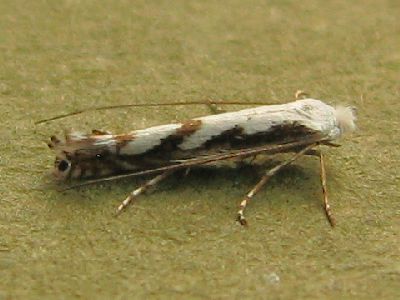

- 37.043 Coleophora niveicostella (Thyme Case-bearer / Drab Case-bearer), pRDB3.
When the first specimen was found here in early August 2012 it was the first Glos. record for the species since 1916,
although a few days later the species was also found on Cleeve Common near Cheltenham.
The larva feeds on Thyme, and like other species in the genus it lives inside a tubular case
from which it mines into a leaf after cutting a circular hole in its surface. The case is made from a
mined-out foodplant leaf and silk. Wingspan approx. 12mm, the forewings are narrow and pale brown with
a white leading edge for part of their length. The species is quite similar to several others in the
genus, but it can be recognised from the combination of its wing markings and its plain white unringed antennae
(see photos below). Also found here in 2013, 2014, 2015, 2017, 2021 & 2024, with records from late May to early August.


- 47.008 Epermenia profugella (Tawny Drab / Little Lance-wing), pRDB2.
A male of this species was found in August 2012,
the first Glos. record since 1983. It was taking nectar on a flowerhead of the umbellifer
Burnet-saxifrage (Pimpinella saxifraga), which grows abundantly on the grassland and is
one of the larval foodplants for this species. The moth is small (wingspan approx. 9mm) and
plain dark brown (photos below). Also found here in 2014, 2015 & 2020, with records from late July to mid August.
A new site for the species was found nearby in 2015, and another near Cheltenham in 2022.
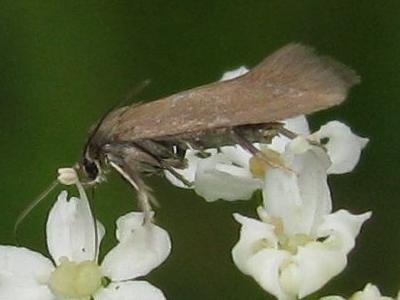
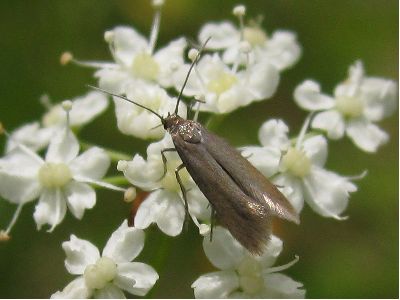
- 49.099 Phalonidia gilvicomana (Wall Lettuce Straw / Wall-lettuce Conch), pRDB3.
A specimen of this species was found in July 2020 flying around
one of its larval foodplants, Wall Lettuce, which grows in some shady spots on the reserve.
Two more were found in June 2021, and the egglying female shown below in July 2021. Also found in 2022.
Since 2000 the moth has been recorded in June and July from several nearby Cotswold tetrads, and also from a site
in the Wye valley.


- 49.364 Pammene suspectana (Ash Bark Tortrix / Ash-bark Piercer), pRDB2.
After it was rated as rare in the UK, this species has become widely recorded because the males are attracted
to the pheromone lures designed for this species (SUS lure) and also those for the tortrix moth species
Grapholita funebrana and G. molesta (FUN and MOL lures, respectively).
The species has been recorded from more than 25 UK vice counties since 2000.
One male was found using the SUS lure at Rough Bank in May 2023 (photo below left, wingspan approx. 12mm).
Recorded from 6 Glos. tetrads in 2022, from mid April to late May. The larvae are thought to feed under
the bark of ash trees. (1 record)
- 63.039 Mecyna flavalis (Chalk Hill Pearl / Yellow Pearl), pRDB3.
A specimen of this species was found in late July 2022.
Possibly expanding its range; the first Glos. record was one week earlier a few miles away.
Photo above right © Steve Whitehouse. (1 record)
Scarce Species (Na)
9 species rated 'Nationally Scarce A' (also known as 'Nationally Notable a', abbreviated to 'Na')
have been recorded at Rough Bank since 2012. These are species believed
to occur in from 16 to 30 10Km O.S. map grid squares in the UK.
- 4.065 Trifurcula cryptella (Cryptic Dot / Wood Lotus Pigmy). Very similar in appearance to
T. subnitidella above but with a slight pale mark on the dark forewing.
The larvae of this species mine the leaves of Bird's-foot Trefoil (Lotus corniculatus)
and the adults have been recorded from the end of April to mid May.
The species has also been recorded at two other Cotswold sites in recent years.
- 4.074 Etainia sericopeza (Norway Maple Dot / Norway-maple Pigmy).
Another tiny moth, the larvae of this species
mine from the keys into the seeds of Norway Maple, and they can perhaps also use Field Maple.
There are scattered records from several parts of the county, mostly from leaf mines. The few adult records
are in August and September. Dark wings with large creamy-white markings, it looks almost identical to another
species but can be identified by microscopic examination. (1 adult record)
- 4.096 Ectoedemia arcuatella (Strawberry Dot / Strawberry Pigmy).
The larvae of this species make distinctive
mines in the leaves of Wild Strawberry as shown below. Its mines were first found in Gloucestershire in 2009 since when they
have been found in numerous places in the Cotswolds and at a few sites in the Forest of Dean and Wye valley.
They have been recorded from mid September to mid November. The adult moth is tiny (wingspan 5mm) and has dark
forewings with a silvery stripe crossing at about the middle.
- 19.009 Digitivalva perlepidella (Spikenard Moth / Spikenard Fanner).
This species is quite widespread in the Cotswolds, usually being
recorded as larval mines in the leaves of Ploughman's Spikenard (Inula conyza), mostly in April.
The adults are easy to identify from their forewing markings, but are rarely seen.
Wingspan approx. 11mm. Larval mine and adult are shown below.
- 37.019 Coleophora trigeminella (Scarce Thorn Case-bearer).
One of numerous species in the genus with no distinctive wing-markings, a specimen
came to light at Rough Bank in June 2024. Recorded from only 4 other sites in the county from mid June to mid July,
with the first Glos. record made in the Forest of Dean in 2009. Its larvae feed on rosaceous trees and shrubs.
- 49.032 Zelotherses unitana (Northern Grey Tortrix).
Very similar in appearance to the common species Z. paleana
(Timothy Tortrix), Z. unitana escaped notice in the county until 2013 but it has since been found on
numerous Cotswold sites from mid May to mid July. Its larvae feed on a variety of herbaceous plants.
The photo below left is of an adult male reared from a larva found on knapweed at Rough Bank.
- 49.075 Acleris umbrana (Dark-streaked Tortrix / Dark-streaked Button).
An almost uniformly dark specimen of this tortrix was one of 194 species which came to light during a very hot night in July 2022.
The photo above right is of a more typical-looking specimen.
Recorded from several places in the county, mostly from November to March. (1 record)
- 49.169 Celypha aurofasciana (Gold-barred Marble / Moss Marble).
This species has distinctive bands across the forewings (photo below left).
A specimen came to light on Rough Bank in late June 2024. New to the county in 2014 and with only 4
Glos. records prior to 2024, it has been recorded in the county from late June to mid July. (1 record)
- 70.021 Lace Border (Scopula ornata). A conspicuous moth (photo above right) which flies in the daytime,
this species is regularly found on two Cotswold sites with occasional records elsewhere in those areas.
It was not found at Rough Bank until 2019 suggesting that the individual was a 'wanderer' from the site near Slad,
but thyme is one of its larval foodplants so it could become a resident species. (1 record)
(records from 23 UK 10Km squares 2000-2016)
Scarce Species (Nb)
40 species rated 'Nationally Scarce B' (also known as 'Nationally Notable b', abbreviated to 'Nb')
have been recorded at Rough Bank. These are species believed
to occur in from 31 to 100 10Km O.S. map grid squares in the UK.
- 4.020 Stigmella paradoxa (Scarce Hawthorn Dot / Scarce Thorn Pigmy).
Found as larval leaf-mines at the tips of Hawthorn leaf-lobes,
there are recent records of this tiny species from a few other Cotswold sites. The forewings are plain
bronzy brown, purplish at their tips. Wingspan approx. 5mm. The photos below show a mine in September
viewed from the leaf upperside (left), and underside (right) with the remains of the egg by the left edge
of the leaf, below the tip of the lobe. (1 leaf-mine record)
- 4.049 Stigmella aeneofasciella (Brassy Dot / Brassy Pigmy).
Mostly recorded as larval leaf-mines on Agrimony in autumn, there are
recent records of this tiny species (photo below left, wingspan approx. 5mm) from three other sites
within a few miles of Rough Bank and from a site in the Severn vale.
There are two generations each year. Adults have been found from late April to mid May.
The vacated mines below were found in November.
- 4.051 Stigmella poterii (Burnet Dot / Downland Pigmy).
Usually recorded in the Cotswolds as larval leaf-mines on Salad Burnet,
the species also uses Tormentil. The adults have dark forewings with a pale metallic stripe well beyond the middle.
Wingspan approx. 4mm. There are two generations each year, described as April - May and July, but the few
recent Gloucestershire records of adults are mid March at Rough Bank, late April and late June at other sites.
The mine in the photo (below left) was found on Salad Burnet in late September. (1 adult record)
- 4.076 Etainia decentella (Sycamore Seed Dot / Sycamore-seed Pigmy).
Another tiny moth, the larvae of this species mine from the keys into the seeds of Sycamore.
Most Gloucestershire records are of the distinctively-marked adult (photo above right),
from late May to mid September, nearly all to the east of the Severn. (1 adult record)
- 4.088 Ectoedemia heringella (Speckled Holm Oak Dot / New Holm-Oak Pigmy).
The larvae of this tiny species mine the leaves of evergreen Holm Oak, which has not yet been recorded on the
reserve but is now found on so many sites in Gloucestershire that it probably grows close to
Rough Bank. Most records of the species are made from its leaf-mines,
mostly to the east of the River Severn. Four adult males came to light in July 2024; they have
distinctive patches of brown scent-scales under their forewings and on their hindwings. (1 record)
- 7.002 Nemophora metallica (Scabious Longhorn / Brassy Long-horn).
One of the "long-horn" moths with very long antennae relative to the body size (particularly the males).
Found on many unimproved Cotswold grassland sites, its larval foodplants are Field and Small Scabiouses.
Adults (wingspan approx. 18mm, photo of male below left) are mostly found in July and August.
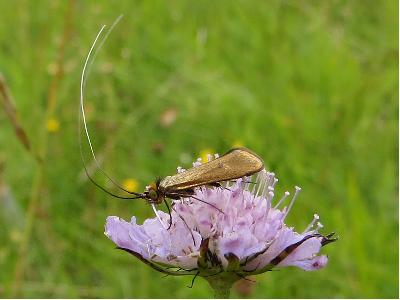
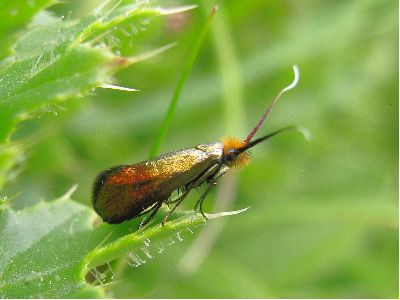
- 7.003 Nemophora cupriacella (Copper-tip Longhorn / Coppery Long-horn).
Smaller than N. metallica, slightly larger than N. minimella
(see below) and quite similar in appearance to that species, this species is parthenogenetic.
Only females are found, and these lay fertile eggs without mating. In the photo of the female (above right)
the antennae thicken more noticeably towards the base than those of N. minimella (below right).
New to Vice-county 33 (East Gloucestershire) when found at Rough Bank in 2012,
it has since been found at a few other Cotswold sites. The adults are usually found in late June or July.
Larval foodplants are Field, Small and Devil's-bit Scabiouses.
- 7.005 Nemophora minimella (Small Scabious Longhorn / Small Long-horn).
Larvae of this species feed on Small Scabious or Devil's-bit Scabious.
Adults (wingspan approx. 12mm) are found in July and August.
Recorded from a few other Cotswold sites since 2000. Photos below of male (left) and female (right).
- 12.017 Nemapogon koenigi (White-speckled Fungus Moth / White-speckled Clothes Moth).
Recorded from several sites around the county, the larvae of this
species feed in rotten wood and bracket fungi. The forewings are dark brown with white spots and streaks,
mostly around the wing edges (photo below left). The wingspan is quite variable, up to 14mm.
Adults are mostly found from June to August.
- 14.001 Bucculatrix cristatella (Yarrow Tuft / Crested Bent-wing).
A tiny species (wingspan approx. 6mm) with plain pale ochreous grey wings (photo above right).
Its larvae feed on Yarrow. An adult came to light on the reserve in July 2021.
There are single post-2000 records from a few other Cotswold sites. (1 record)
- 15.001 Parectopa ononidis (Clover Stilt / Clover Slender).
Recorded from several other sites in the Cotswolds and Severn Vale. The larvae of this
small species (wingspan approx. 8mm) mine the leaves of Restharrows or Clovers. The narrow forewings are
dark brown with several silvery streaks inwards from the leading and trailing edges (photo below left).
First generation adults have been recorded in May or June,
and second generation from mid July to late August.
- 15.057 Phyllonorycter dubitella (Goat Willow Leaf-miner / Southern Midget).
Found as larval leaf-mines on Goat Willow, this small moth
(wingspan approx. 7mm) is similar in appearance to many others in the same genus, with golden-brown forewings marked
with black-edged white streaks (photo avove right). There are two generations each year, with adults recorded from
several sites in the county in April/May and September. (2 records of leaf-mines, adults reared from these)
- 17.006 Ypsolopha horridella (Dark Tufted Scallop / Dark Smudge).
Recorded at several sites around the county mostly in August, this species is easily recognised from the
shape of the dark wings and the tufts of raised scales (photo below left, wingspan up to 21mm).
Larvae feed on apple or blackthorn. (2 records)
- 17.014 Ochsenheimeria taurella (Hairy Stem Moth / Feathered Stem-moth).
Recorded in a few sites in the county, adults of this species
have their antennae noticeably thickened by scales for more than half of their length (photo above right).
Larvae feed on various grasses, and adults have been recorded in July and August.
Wingspan approx. 12mm, some forewing scales are loosely attached and give the
mottled brown wings a rough appearance.
- 32.025 Agonopterix nanatella (Carline Buff / Carline Flat-body).
First found at Rough Bank in 2012 but not previously in the county
since 1937, this moth has buff forewings with a thick scattering of darker scales, wingspan approx. 16mm.
The larval foodplant is Carline Thistle - the photos below show a leaf-tube formed by the larva using its
silk, and a tube opened to show the larva. Adults fly at dusk and come to light, and have been
recorded in August. In recent years also found on several other Cotswold grasslands.
- 35.080 Oxypteryx unicolorella (Bronze Neb / Unmarked Neb).
The larval foodplant for this small, plain dark glossy moth
(photo below, wingspan approx. 12mm) is uncertain, but Perforate St John's-wort is thought to be a possibility.
Recorded in June and July at several Cotswold sites and also west of the Severn.
- 37.061 Coleophora lixella (Downland Case-bearer).
Found in June and July at several sites across the Cotswolds.
Larvae of this species feed initially on Thyme and later in their development on grasses.
Photos below of a larval case made from part of a grass leaf, and an adult (wingspan approx. 18mm).
- 37.081 Coleophora therinella (Black Bindweed Case-bearer / Black-bindweed Case-bearer).
New to Gloucestershire when an adult came to light here in July 2012,
this is the only species listed here whose larval foodplant is not thought to grow on the site:
it uses Black-bindweed (Fallopia convolvulus) which is often found on arable land.
Wingspan approx. 14mm, like several other species of the genus its narrow forewings are
dull pale greyish or brownish with a pattern of whitish streaks,
showing much less contrast than C. lixella above. (1 record)
- 38.003 Stephensia brunnichella (Basil Blotch-miner / Basil Dwarf).
A small brown moth with silvery markings
(wingspan approx. 8mm, photo below). Larvae of this species mine the leaf-tips of Wild Basil.
It has been recorded at numerous Cotswold sites either as adults or as larval mines.
First generation adults mostly fly in May and June, second generation in August and September.
Elachista species. The species listed below from this genus are all small, with wingspans
in the range 7 - 10mm. Their larvae feed on sedges &/or grasses.
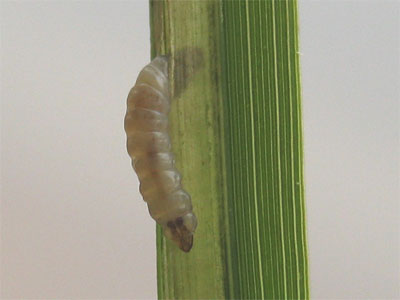

- 38.007 Elachista subocellea (Brown-barred Grass-miner / Brown-barred Dwarf).
Forewings with three broad yellow-brown stripes (faint in some specimens,
particularly worn ones) across pale wings with scattered dark scales.
Photos below of a well-marked specimen and a worn one.
Recorded from sites across the Cotswolds and a few in the Severn vale, mostly from late May to early July.
The two photos above show a fully-fed larva leaving its mine in a blade of Tor Grass, and on its way down the grass stem
(it later pupated near ground level).
- 38.010 Elachista bedellella (Oat-grass Miner / Grey Dwarf).
Forewings with three greyish areas separated by a pale stripe
and a pair of pale spots (one on the leading edge, the other on the trailing edge)
which can form a second stripe. Photos below of a male (left) and female (right).
Recorded from a few Cotswold sites in two generations during the period from mid May to August.
(1 record)
- 38.023 Elachista biatomella (Twin-spot Sedge-miner / Two-dotted Dwarf).
Forewings pale with scattered dark scales giving a greyish appearance,
with two prominent dark spots (photo below left).
Worn specimens can lose some or almost all of the greyish effect, as in the photo below right.
Very worn specimens can resemble E. triatomea.
Recorded from sites across the Cotswolds and one in the Forest of Dean. It is seen from April through to mid September, with most in May and June.
- 38.033 Elachista subnigrella (Dingy Grass-miner / Dark Dwarf).
Male forewings greyish with faint paler markings, the females
showing more contrast with a darker background, a pale stripe across the middle of the wing
and two pale spots beyond this (photo below left).
Recorded from several Cotswold sites, records from April through to August.
- 38.041 Elachista cinereopunctella (Glaucous Sedge-miner / Grey-spotted Dwarf).
Forewings dark with a white stripe across the middle of the wing,
usually not reaching the trailing edge, and two white spots beyond this (one on the leading edge,
the other on the trailing edge). The female wings show more contrast, with darker background and larger
white markings than the males (photos above right: larva in mine on glaucous sedge,
below: male on left, female on right).
Recent records in Glos. from a few other Cotswold sites and the Wye valley, adults in late May and June.


- 38.048 Elachista consortella (Meadow Grass-miner / Field Dwarf).
Male forewings with mixed white and darker scales giving a greyish
appearance with obscure paler markings, the females show more contrast with a dark background, a white stripe
across the wing and two white spots beyond this (one on the leading edge, the other on the trailing edge).
Recent records from several other Glos. sites, the species has been recorded in April & May and late July to September.
- 39.002 Blastodacna atra (Apple Pith Moth).
Recorded at numerous sites in the county, mostly from June to August. The
larvae of this small moth mine inside twigs of apple trees. Wingspan approx. 11mm, forewings mostly dark brown
with two small raised tufts of dark scales near the trailing edge, and some pale or white markings (photo below).
- 40.014 Mompha terminella (Enchanter's Mompha / Enchanters Mompha).
Recorded in Cotswold woodlands and the Forest of Dean, this species
is usually found as the distinctive larval leaf-mines on Enchanter's Nightshade (photo below, left),
mostly in September, rather than as adults in July.
Wingspan approx. 8mm, forewings dark orange with various white, grey and darker markings.
- 43.004 Scythris picaepennis (White-dusted Runner / White-dusted Owlet).
This is a small, very dark moth (wingspan approx. 10mm).
It can be unmarked and very similar in appearance to S. subcinctella below, but it often has a
scattering of paler scales on the forewings as in the photo (above, right). This species uses Thyme and
Bird's-foot Trefoil as its larval foodplants. It is found on many Cotswold grassland sites, in a
single generation mostly from late May to July.


- 43.005 Scythris subcinctella (Rock-rose Runner / Copper Owlet).
Also found on many Cotswold grassland sites, this small, plain dark
bronzy moth (photo above, left) uses Common Rock-rose as its larval foodplant. Wingspan approx. 10mm. Described in some books as
univoltine, it has two generations here: adults are mostly recorded from late May to July or early August,
and again from late August through September.
Photo of a nectaring group of second generation adults above right,
taken at another Cotswold site on 18 September 2012.
- 45.025 Small Plume (Oxyptilus parvidactyla). Found on many Cotswold grassland sites mostly
southwards from Cheltenham. Larvae of this species feed on Mouse-ear Hawkweed. Adults have been
recorded from late May to mid July. Photo below left, wingspan approx. 14mm.
- 49.114 Aethes hartmanniana (Lesser Marbled Straw / Scabious Conch).
This tortrix moth has very similar markings to A. piercei
below, but is smaller on average. Its wingspan is usually in the range 11-17mm, compared to 15-24mm for
A. piercei. Its larvae are thought to feed in the roots of Field or Small Scabious; those of
A. piercei feed in the roots of Devil's-bit Scabious.
A. hartmanniana has been recorded on a few Cotswold grasslands, from May to July. Photo above right.
- 49.115 Aethes piercei (Greater Marbled Straw / Devil's-bit Conch).
See A. hartmanniana above. Recorded from one other Cotswold site since 2000. (1 record)
- 49.135 Cochylis flaviciliana (Pink-shaded Straw / Gold-fringed Conch).
The forewings of this tortrix moth are creamy yellow close to the body,
bright pink towards their tips, with a reddish-brown stripe across the middle (wingspan 11-16mm, photo below).
The larvae feed on Field Scabious. There are recent records from a few other Cotswold sites; adults are found
from mid June to mid August. (1 record)
- 49.221 Rhopobota stagnana (Scabious Marble / Downland Bell).
Found on several Cotswold grassland sites. The larvae of this species
feed on Small and Devil's-bit Scabiouses. There are two generations: adults are mostly recorded from early
April to early June and from mid July to mid August. The males (photo below left) are obscurely marked,
the females (photo below right) have much stronger contrast between the paler and darker areas. Wingspan quite variable,
averaging approx. 15mm in the male and 12mm in the female.
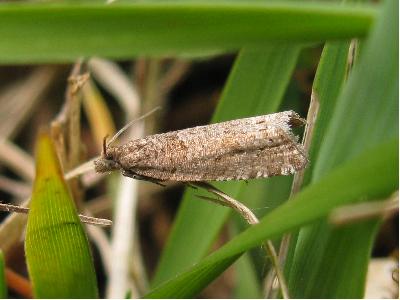

- 49. Pammene giganteana (Early Oak Gall Moth / Early Oak Piercer).
After it was rated as scarce in the UK, this species has become widely recorded because the males have been
found to be attracted to the pheromone lures designed for other tortrix moth species, particularly
those for Grapholita funebrana and G. molesta (FUN and MOL lures).
That was how one was found at Rough Bank in April 2023, with a FUN lure by an oak tree (the larvae feed inside oak galls).
The wingspan is approx. 15mm. Adults (two photos below) are found from March to May. (1 record)
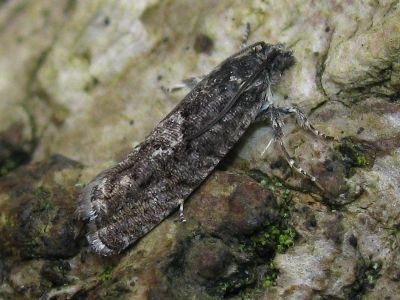
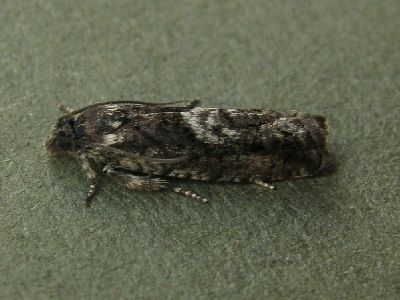
- 54.003 Cistus Forester (Adscita geryon). Found on many unimproved Cotswold grassland sites,
its larval foodplant is Common Rock-rose. Adults (photos below, male on left) are mostly found in May and June.
Their forewing colour varies from dark green to yellowish green. Being a quite conspicuous day-flying moth,
the single record of one individual suggests that the species is not resident on the site at present.
(1 record)
(records from 62 UK 10Km squares 2000-2016)
- 62.030 Hypochalcia ahenella (Dingy Knot-horn).
Found on several Cotswold grassland sites. The larval food is
uncertain, Rock-rose is thought to be a possibility. Recorded from mid May to early July, adults are very
variable in both size (wingspan 22 - 32mm) and shade of brown, with some specimens much darker
than the two shown below.
- 63.109 Pediasia contaminella (Rolled Grass-moth / Waste Grass-veneer).
One of the 'grass moths', this species had not been recorded in the county since the 19th century until a specimen was
light-trapped at Rough Bank in July 2020. The wings are sandy-brown, usually with some darker line markings
which can be obscure. It is typically found in dry grassy habitats in July and August. (1 record)
- 70.117 Drab Looper (Minoa murinata). Recorded in many woodland areas in the county. The larval
foodplant is Wood Spurge. Adults fly in the daytime, with most records from mid May to early July but some
from a partial second generation until late August. Photo below left.
(records from 62 UK 10Km squares 2000-2016)
- 70.165 Pimpinel Pug (Eupithecia pimpinellata). Looking very similar to several other species of Pug moth,
its larvae feed on Burnet-saxifrage. Recorded at a few other Glos. sites since 2000, with records from mid July to late August. Photo above right.
(records from 74 UK 10Km squares 2000-2016)













